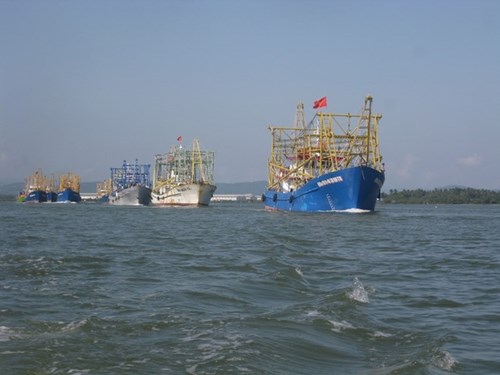The central city of Da Nang is home to an over-70km-long coastline, a fishing ground of 15,000sq.km, and fishery reserves of about 1.14 million tons.
Deputy Director of the municipal Department of Agriculture and Rural Development Nguyen Do Tam said that over the 10 years of realizing Vietnam’s Maritime Strategy, Da Nang has successfully summoned resources to develop its sea-based economy with a focus on support policies for the fishing community.
Aside from the Government’s support, Da Nang has issued its own “breakthrough” policies to support fishermen over the past few years, including those on managing inshore fishing activities, developing offshore fishing fleets, and protecting and developing fishery resources.
    |
 |
|
Da Nang invests efforts in developing sea-based economy |
These policies have encouraged fishermen to upgrade and build boats for offshore fishing, thus helping to improve the quality and value of local seafood, he noted.
In 2012, the municipal administration issued Decision No.7068/QD-UBND on policies assisting the industry with building new fishing supply boats. This was considered a “breakthrough” decision and a “revolution”, helping to change the structure of the local offshore fishing fleet.
Under this decision, fishermen received VND 500 million (USD 21,400) in cash to support them in building a new boat with the capacity of between 400CV and under 600CV; VND 600 million (USD 25,700) for building a boat with a capacity ranging from 600CV to under 800CV; and VND 800 million (USD 34,200) for building a boat of over 800CV.
There have been 84 boats built under this decision so far, with total financial aid of more than VND 66 billion (USD 2.8 million), raising the number of boats with the capacity of over 90CV to 583 – a three-fold rise from 2010.
Tam added that to capitalize on local advantages and opportunities in the market, the city’s fishing sector is working to improve the fishing community’s access to capital, while improving their offshore fishing skills and the competiveness of processed seafood. Between 2016 and 2020, the sector has been focusing on restructuring the fishing fleet and keeping the catch stable.
Da Nang is also developing vessels supplying fisheries logistic services so as to raise the number of logistics vehicles to 15 by 2020 and 50 by 2030.
It looks to increase the caught seafood volume to 38,000 tons by 2020 and 45,000 tons by 2030, the official said.
Apart from the aforementioned support policies, the city plans to press on with others to protect and ease the fishing pressure on inshore aquatic resources. It will also further assist fishermen in seafood storage to minimize losses after catching.
In September 2017, the city approved a plan on developing its sea-based economy towards 2025, with a vision to 2030. Accordingly, it has set a target for the tourist number growth rate at about 13 percent between 2016 and 2030, and the volume of cargo handled at local seaports at 12-13 percent by 2025. It also looks to have the output of processed seafood for export rising by 12-13 percent by 2025 and 8-10 percent by 2030.
Concrete activities are being carried out to create new tourism products relating to marine sports and the yacht industry, to perfect coastal tourism infrastructure, and to enhance knowledge amongst tour guides on marine sovereignty.
Meanwhile, the city is also working to turn Da Nang Port into an international gateway with the Tien Sa and Lien Chieu terminals. Tien Sa terminal will specialize in serving passenger ships and cruises, while Lien Chieu terminal will serve cargo transportation.
Resources are being spent on raising the capacity of the local fishery surveillance force, improving the information system for the management of fisheries, and promoting contact with fishing boats to ensure safety for vehicles and workers at sea.
Seafood processing companies have also been encouraged to apply cleaner production technologies to reduce waste, save materials and energy, and effectively treat sources of pollution.
Total capital needed for developing sea-based economy is estimated at over VND 19 trillion (USD 813 million) for 2017-2020, VND 13 trillion (USD 556.3 million) for 2021-2025, and VND 17 trillion (USD 727.4 million) for 2026-2030.
Source: VNA